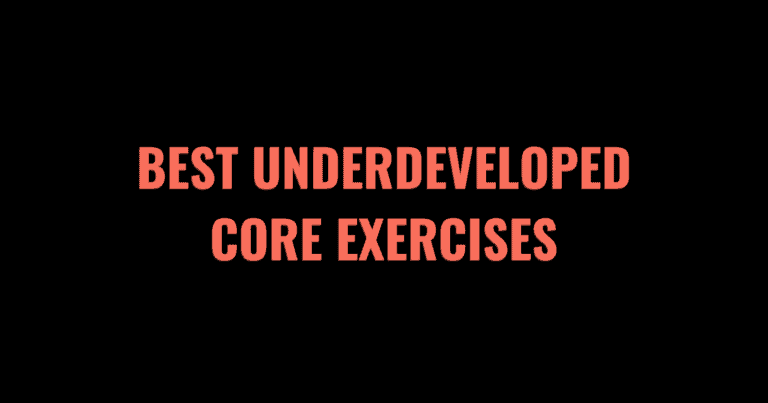Do you want to improve your posture and build a fuller, more muscular upper body? Your rear delts are crucial for well-rounded shoulders and a healthy spine and shoulders. Many popular shoulder exercises focus on the anterior (front) and medial (side) deltoid muscles. Read on to learn how to target underdeveloped rear delts for stronger, healthier, and more muscular shoulders.
Underdeveloped rear delts occur when the muscles on the back of your shoulders are smaller or weaker than other muscle groups in your upper body, like the front or side deltoids or the traps. Common reasons for underdeveloped rear delts include neglecting targeted posterior delt exercises, poor technique, and a weak mind-to-muscle connection with this small muscle group.
You can grow underdeveloped rear deltoids by increasing your weekly rear delt training volume, perfecting your technique, and moving through a full range of motion. You can also use advanced techniques like pauses and tempo work for added time under tension.
We’ll explore these methods for growing underdeveloped rear delts in more detail, so you can start building the boulder shoulders of your dreams.
Table of Contents
- 1 The 7 Best Ways to Grow Bigger Rear Delts
- 1.1 1. Do rear delt exercises earlier in your session
- 1.2 2. Increase your weekly rear delt training volume
- 1.3 3. Include effective rear delt isolation exercises
- 1.4 4. Perfect your technique
- 1.5 5. Utilize tempo work and isometrics
- 1.6 6. Use an optimal range of motion
- 1.7 7. Include varied types of resistance
- 2 The 8 Best Exercises for Growing Rear Delts
- 3 What are Underdeveloped Rear Delts?
- 4 Rear Delt Anatomy
- 5 Growing Rear Deltoid FAQs
- 6 Grow Underdeveloped Muscle Groups
- 6.1 The 7 Best Ways to Grow Underdeveloped Obliques
- 6.2 The 8 Best Ways to Grow Bigger Hamstrings
- 6.3 The 8 Best Ways to Grow Bigger Biceps
- 6.4 The 8 Best Ways to Grow a Bigger Lower Chest
- 6.5 The 8 Best Ways to Strengthen Abs
- 6.6 The 8 Best Ways to Grow Bigger Traps
- 6.7 The 8 Best Ways To Grow a Bigger Upper Chest
- 6.8 The 8 Best Ways to Grow a Bigger Back
- 6.9 The 8 Best Ways to Grow Bigger Front Delts
- 6.10 The 8 Best Ways to Grow Bigger Upper Abs
- 6.11 The 8 Best Ways to Grow Bigger Shoulders
- 6.12 The 8 Best Ways to Build an Underdeveloped Core
- 6.13 The 5 Best Ways to Grow Bigger Triceps
The 7 Best Ways to Grow Bigger Rear Delts
- Do rear delt exercises earlier in your session
- Increase your weekly rear delt training volume
- Include effective rear delt isolation exercises
- Perfect your technique
- Utilize tempo work and isometrics
- Use an optimal range of motion
- Include varied types of resistance
1. Do rear delt exercises earlier in your session
Pull sessions often focus on your biceps, back, and lat muscles. Lifters often leave rear delt work till the end, if they remember to do it at all. A 2021 meta-analysis found that exercise order influences muscular strength gains, with exercises performed first yielding better strength gains. If your rear delts lack strength, high-quality rear delt training early in your session will help strengthen them faster. You will also have more mental and physical energy at the beginning of your workout, giving you a better chance of smashing out effective reps and sets.
2. Increase your weekly rear delt training volume
Adequate training volume is one of the best predictors of hypertrophy and strength gains for any muscle group. The Renaissance Periodization training volume landmarks recommends 16-22 sets of rear delt training per week to keep seeing progress. Since the rear delts are a smaller muscle, they recover relatively quickly and can handle higher volume.
A solid approach is to slowly increase your weekly volume with one or two additional sets of direct rear delt training per week until you are within this range and no longer recover well between sessions.
3. Include effective rear delt isolation exercises
Even if you’re doing plenty of pulling volume, your rear delts won’t grow unless you effectively target them. Popular pulling exercises like lat pulldowns and bent-over rows are great for your lats but won’t help you break through strength and hypertrophy plateaus for your rear delts.
Isolation rear delt movements like machine reverse flys and face pulls are more effective at activating the posterior deltoid than other rowing or pulling exercises. If you aren’t already doing these exercises, start using them regularly to strengthen weak or small rear delts.
4. Perfect your technique
Due to their small size and location on the back of your shoulders, you may need help maintaining a mind-to-muscle connection with your rear delts. Perfecting your technique through the support of a coach or watching visual demonstrations of the best rear delt exercises can help you adjust your movements to better target the rear delts.
Some sound general principles to remember are keeping your shoulder blades retracted and pulling them down to minimize trap engagement. You should also flare your elbows and utilize a neutral grip whenever possible. This video from Jeff Nippard gives some helpful tips on perfecting your form for popular rear delt exercises.
5. Utilize tempo work and isometrics
Advanced training techniques like isometric holds and tempo sets can increase intensity without adding more weight or volume. Tempo work and isometrics increase time under tension, strain the deltoid muscle fibers to stimulate more metabolic damage and trigger hypertrophy. You can pre-fatigue your rear delts by doing banded rear delt fly isometric holds before moving on to your working sets for greater muscular strain.
Emerging research suggests combining slower movement in the eccentric (lowering) phase with faster movement during the concentric (lifting) phase to achieve hypertrophy and strength gains. In practice, this could look like doing face pulls with a fast concentric portion (as you pull the cable towards you) and then slowing down as you extend your arms.
6. Use an optimal range of motion
A full range of motion is usually optimal for maximum hypertrophy gains, but research suggests a partial range of motion can also effectively build bigger rear delts. You should still aim to fully stretch and contract the deltoids in each rep, but in many rear delt exercises, the peak tension is at the top of the lift when your shoulder blades squeeze together and your elbows are behind your torso.
Partial reps emphasize the point of maximum contraction when the rear delts are under the most strain. Combining full range of motion reps with targeted partial reps helps stimulate new muscle growth in stubborn areas and build strength in the hardest part of any rear delt exercise.
7. Include varied types of resistance
If you only train your upper body with one type of weight, like barbells and dumbbells, consider using machines and cables to target your rear delts. Free weights are fantastic for functional fitness and lifting the heaviest weights possible, but there is a lot to gain from cables and machines, especially for the rear delts.
Cable rear delt exercises create constant muscle tension, while dumbbells are great for allowing a flexible range of motion and isolating the rear delts. Machine rear delt exercises help perfect your movement pattern, while bodyweight rear delt exercises are convenient when equipment is limited.
The 8 Best Exercises for Growing Rear Delts
- Machine Reverse Flys (aka Reverse Pec Deck)
- Seated Rear Delt Rows
- Bent Over Rear Delt Flys
- Standing Reverse Cable Flys
- Cable Single-Arm Rear Delt Fly
- Cable Face Pulls
- Incline Dumbbell Face Pull
- Incline Rear Delt Raise
Check out this complete list of the best rear delt exercises for comprehensive how-tos and technique tips to build bigger rear delts.
What are Underdeveloped Rear Delts?
Underdeveloped rear delts occur when your posterior deltoid muscles are smaller or weaker than neighboring muscle groups. Many upper-body pulling exercises emphasize the lats, rhomboids, and traps over the rear deltoids. Over time, this can cause your shoulders to look asymmetrical, give you a hunched posture, and increase your pain and injury risk.
Underdeveloped rear delts are a common problem for athletes because they are harder to target and maintain a solid mind-to-muscle connection with. This problem is exacerbated by poor posture and internal shoulder rotation when sitting at a desk or driving. To remedy weak rear delts, ensure your exercise selection is appropriate, that your volume is sufficient, and that your technique is perfect.
Here is an example of how you can use some of the best rear delt exercises in your weekly training plan.
- Day 1 – Rear Delt Dumbbell Fly: 3 sets x 12 reps @ 60%, Cable Face Pull: 3 sets x 10 reps @ 70%
- Day 3 – Machine Reverse Fly: 4 sets x 12 reps @ 60%
- Day 5 – Standing Reverse Cable Fly: 3 sets x 15 reps @ 50%, Incline Dumbbell Face Pull: 3 sets x 10 reps @ 70%
Rear Delt Anatomy
Your rear delts are one of three muscle heads that comprise your shoulder muscles. The rear delt is located behind you, spanning the scapula to the upper arm bone (humerus) along with the medial (side) and anterior (front) delts. The rear delts synergize with the scapula retractors, rhomboids, and traps to pull your shoulders back and avoid excessive internal rotation (hunching).
Rear delts are often neglected in upper body training programs, worsening the tendency for desk workers to have a weak upper posterior chain. Weak rear delts increase your risk of back and shoulder pain, tightness, and injuries. Conversely, building strong, stable rear delts will not only improve your performance in the gym but will also improve your posture and functional fitness for activities of daily living.
Check out the video below to learn more about deltoid anatomy and function.
Growing Rear Deltoid FAQs
How often should you train your rear delts?
No additional rear delt work is required to maintain your current size and strength as long as your program includes sufficient pulling exercises for the back. To see hypertrophy and strength gains, you need more volume.
You should do at least two weekly sessions to stimulate new rear deltoid muscle growth. For intermediate-to-advanced lifters or those experiencing stubborn lagging rear delts, train the rear deltoids between three and five times per week.
At what intensity should the rear delts be trained?
Your rear delts respond best to a combination of intensities, compound lifts using higher intensity, and isolation exercises prioritizing higher reps and lower weights.
To optimize hypertrophy, perform 50% of your rear delt training in the 60-70% intensity range. Divide the other 50% between the 30-55% intensity range and the 75-85% intensity range. To ensure an appropriate intensity, take each working set to within 1-3 reps of muscular failure.
What rep range should I use for the rear delts?
Perform at least 50% of your rear delt training in the 10-20 rep range to optimize muscle growth. The other 50% can be split up between the 5-10 rep range and the 20-30 rep range, depending on whether the exercise is a compound (multi-joint) or isolation (single-joint) movement.
What types of exercises target the rear delts?
The main biomechanical functions of the rear delts are transverse shoulder abduction (moving your arms out to the sides horizontally), external rotation, and shoulder extension.
The best isolation exercises for your rear delts include rope face pulls with a neutral grip, machine reverse flys, and reverse dumbbell flys.
Some research suggests isolation exercises are more efficient and effective for targeting the rear delts, with the reverse pec deck or rear delt fly machine outperforming many other exercises. Compound exercises like barbell or Pendlay rows still play an essential role in loading the rear delts with heavier weights. Be sure to flare the elbows to trigger shoulder abduction.
What are the consequences of weak rear delts?
Underdeveloped rear delts can lead to imbalanced strength between your pushing muscles and posterior chain (pulling muscles). The rear delts keep your shoulders pulled back, so if they are weak, you are more prone to a rounded, hunched upper body. You will also notice a lack of pulling strength compared to pushing exercises that work your chest and triceps.
Your rear delts are essential for stabilizing the shoulder joint during compound lifts like bench presses and push-ups, so if they lack strength and mass, you may be at a greater risk of injuries that will set you back in your fitness goals.
Grow Underdeveloped Muscle Groups
If you enjoyed this post, check out our other guides on how to grow lagging muscle groups.












